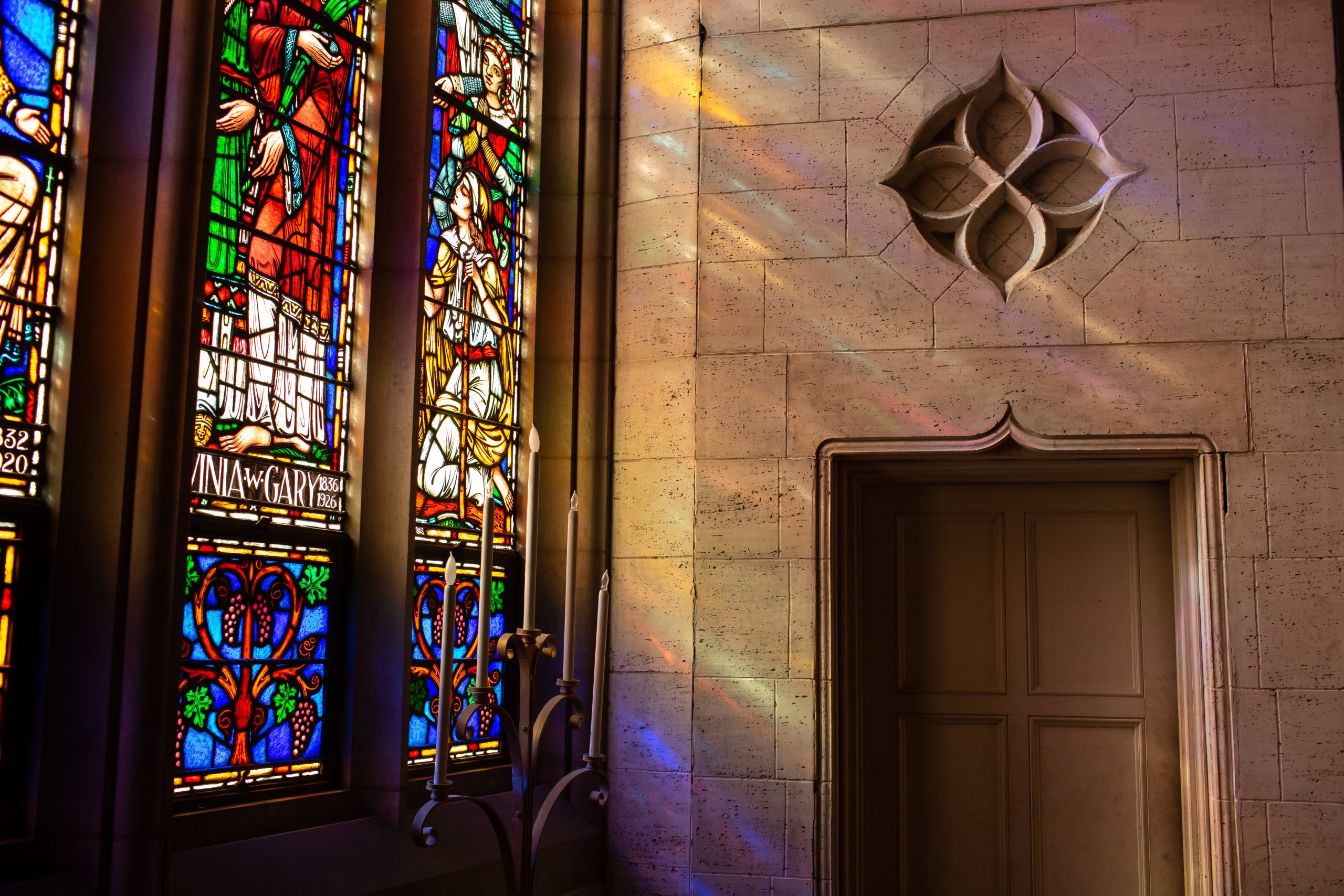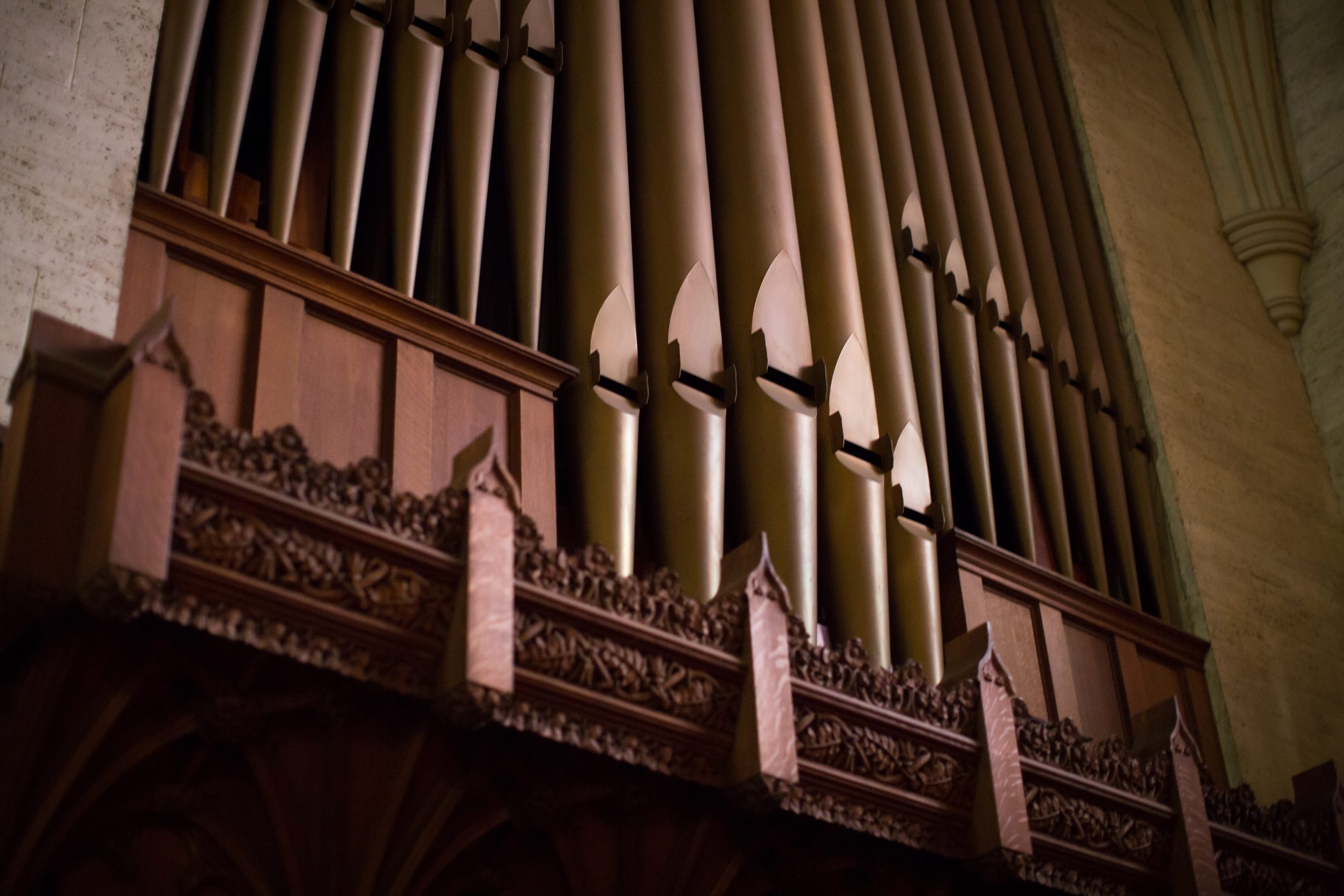Brown Memorial Park Avenue Presbyterian is a Gothic style church built of Baltimore County limestone for $150,000 in 1869-1870. In 1905, transepts were added. From 1905-1910, Tiffany stained glass windows were installed. In 1930, Ralph Adams Cram, the celebrated architect from Boston, redesigned the altar and built the current chancel where the Skinner Company installed the Opus 839, IV/45 pipe organ in 1931. A labyrinth walk and columbarium were added in 2003.
From 2001-2003, Brown Memorial and its windows underwent a $1.8 million restoration through a generous gift from the estate of Mrs. E. Cowles Andrus and matching gifts from 300 congregation members.
Stained glass has been linked with Christian theology since the medieval period. Light was believed to be the source of divine providence and through ecclesiastical stained glass, earthly light transformed to divine light.
At Brown Memorial, our sanctuary is blessed to have 17 American art glass and stained glass windows. At least 11 are products of the Tiffany Studios. Most were installed between 1905 and 1910. Today, they make up one of the world’s largest and finest collections of Tiffany art still in their original setting.
These windows exemplify the highest quality of workmanship and illustrate the novel techniques the Tiffany Studios used to create limitless ranges of hues, colors and textures. Together, with other American art glass windows in Brown, they fill the sanctuary with radiant, transcendent light.
Read more about the history and restoration of our Tiffany Windows in the April 2003 issue of Baltimore Magazine.

Our cell phone audio tour invites visitors to listen and learn about our Tiffany and stained-glass windows, extensive wood carvings, Skinner pipe organ and labyrinth inside the sanctuary.
The highlight of the tour is Brown Memorial’s collection of early 20th Century American art glass, including 11 Tiffany windows. Two of the Tiffany windows—one in each of the church’s transepts—measure 16 feet wide by 32 feet tall and are believed to be among the largest windows created for a church by the Tiffany Studios. The audio tour allows listeners to step close to the windows and learn about the biblical themes they explore, as well as the artistry that went into their creation—follow along using the photo gallery below.
To take the audio tour in-person (ideal!), schedule your visit between 10 AM and 4 PM, Monday through Friday with our Office Coordinator. When you arrive for your visit, you’ll be let into the sanctuary and can dial the audio tour phone number, 410-630-4298.
To take the audio tour remotely simply use the pictures in the gallery below. The audio tour phone number, 410-630-4298, can be dialed from anywhere, at any time of the day.
Most of the 29 audio tour stops are less than three minutes each, so your tour will take approximately 45 minutes.
Brown Memorial’s pipe organ was installed in the chancel in 1931. It was built by the Skinner Organ Company of Boston (opus 839), one of the finest organ builders of the 20th Century. The organ is internationally known and admired by the historic organ community as an exceptional example of the Skinner firm’s work.
G. Donald Harrison, who designed some of the finest and largest pipe organs in the United States for the Skinner Company, tonally finished Brown Memorial’s organ. Except for a few minor volume regulations to several stops over the years, the instrument has had no tonal alterations.
The organ has approximately 3,000 pipes of varying size. Some are large enough to fit a Shetland pony. Others are the diameter of a pencil.

In the early 2000s, the Di Gennaro-Hart Organ Company of McLean, VA, conducted restoration work on the instrument according to historical guidelines. All 11 reed registers underwent museum-quality restoration, and new replica Skinner interior cabinetry and components was installed. The organ has new ivory and Gabon ebony keyboards with tracker touch, and an ample complement of thumb pistons to access the 99 channels of memory of the capture system offers.
Celebrated organist Virgil Fox served as Brown’s organist, while also leading the organ department at the Peabody Conservatory, from 1935-1946. On the organ he worked out his famous arrangement of Bach’s “Come, Sweetest Death.” He later premiered the piece on the John Wanamaker organ in Philadelphia for an American Guild of Organists’ Convention. Fox left Brown to become organist at New York City’s famed Riverside Church.
The great composer and organist Jean Langlais gave two recitals on this organ in the early 1950s at the invitation of his close friend Richard Ross, who succeeded Virgil Fox as Brown’s organist.
Following the sudden death of Richard Ross, F. Eugene Belt who served as Assistant Organist to Mr. Ross was appointed Organist and Director of Music. “Gene” served faithfully for nearly 51 years until his death in 2001. The organ was dedicated to Gene’s memory at that time.
In recent years, renowned organist Dr. John Walker served as Brown’s Minister of Music, and the church’s Minister of Music Emeritus. Interestingly, he reversed Virgil Fox’s trajectory, coming to Brown from New York’s Riverside Church. Brown’s former Minister of Music, Michael Britt, then succeeded John Walker in 2012 through 2022.